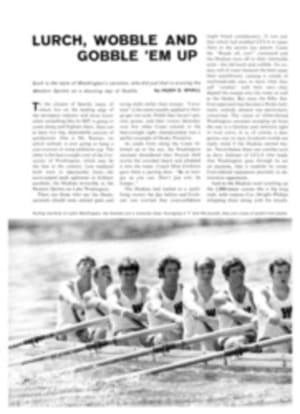
Beef jerky: a convenience food that a customer can sink his teeth into—barely
Jerky, a sort of protein hardtack, is the kind of food one eats to live, rather than the other way around. It is a utilitarian delicacy with a long and fairly honorable history as the frontiersman's version of the astronaut's convenience food, without the plastic wrapper. Given a fire or even hot sun, a strip of meat can be "jerked" in a few days and, once so dried, weighs next to nothing and lasts, in pocket, pack or saddlebag, almost forever. At any time it can be sliced into eggs, soups, stews or just chewed. (Chewing jerky is an entertainment in itself, since it takes even longer to soften up a wad of it than it does to get waited on in a New York restaurant.) Finally, jerky is useful for a variety of odd functions, from patching inner tubes to skipping across ponds.
Today, despite newfangled competition, jerky remains one of the handiest foods available for backpackers, climbers and trail riders. It has more food value and is infinitely easier to use than most of the new "outdoorsman" meats—those aggravating, desiccated, freeze-dried, powdered concoctions which, after they are soaked and cooked, still taste like coal-tar derivatives.
These days the hardest thing about using jerky is finding it. There are several large firms that distribute it to retail chains. Among the better ones who will also sell by mail are Hickory Farms, 1021 N. Reynolds, Toledo, Ohio and Paul Devereaux Food Distributors, 503 S. Park Ave., Tucson, Ariz. Some of the best old-fashioned jerky is produced in what amounts to a cottage industry by an Arizona housewife, Mrs. Ilene St. John. Her product, Western Jerky, is made in her own home at 3380 N. Dodge, Tucson, and is sold by mail.
Mrs. St. John became a commercial jerker after running into a bad batch of the stuff four years ago on a Mexican fishing trip. Almost alone among modern jerky makers, she uses no preservatives or artificial sources of heat in her process. She begins with boned rump roasts frozen hard enough for convenient slicing. The roasts are cut into quarter-inch-thick slabs, then salted and peppered. (Her jerky comes in two flavors: mild and hot, the latter living up to its name.) The slices of beef are then spread on racks in a vented, screened green-houselike shed outside her kitchen. The Tucson sun in three days does the rest.
Mrs. St. John cures about 600 pounds of fresh meat a month, which dries down to 150 pounds of jerky. In addition, she makes up custom orders in any quantity. Suggestion: before ordering a couple of hundred pounds for your next Everest expedition, send for a few sample packets.

